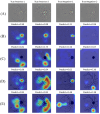Prediction of advanced chronic kidney disease through retinal fundus images by deep learning
- PMID: 41136657
- PMCID: PMC12552513
- DOI: 10.1038/s41598-025-21366-y
Prediction of advanced chronic kidney disease through retinal fundus images by deep learning
Abstract
This study was developed and evaluated deep learning model for detecting chronic kidney disease (CKD) by retinal fundus images. This study included 42,963 clinical visits from 17,442 patients who underwent retinal fundus examination between October 19, 2006, and September 13, 2018, with estimated glomerular filtration rate (eGFR) measurements available within a 7-day interval of the imaging examination. We developed and compared three model configurations: using a single fundus image (Model A), combining a single image with demographic features (Model B), and integrating bilateral fundus images (Model C). We compared two base architectures, EfficientNet-B3 and EfficientNetV2-S, and evaluated the impact of different training strategies: a single model versus a 5-fold cross-validation (CV) ensemble. Model performance was assessed using the Area Under the Curve (AUC), sensitivity, specificity, Positive Predictive Value (PPV) and Negative Predictive Value (NPV). Among all evaluated models, the bilateral-image model (Model C) utilizing the EfficientNet-B3 architecture with a 5-fold CV ensemble strategy demonstrated the best overall performance, achieving an AUC of 0.868, with a sensitivity of 0.792 and a specificity of 0.788 on an independent test set. The performance of this ensemble strategy was statistically superior to its single-model counterpart trained on the full dataset (AUC 0.850, p < 0.001). Among single models, Model B yielded the highest AUC (0.857) and sensitivity (0.794), while Model C offered the highest specificity (0.799), revealing a clinical trade-off between the different approaches. Furthermore, benchmarking against the newer EfficientNetV2-S architecture did not yield a performance benefit in this study. The study exhibited a superior performance in detecting advanced chronic kidney disease in patients with diabetes mellitus through retinal fundus image.
Keywords: Chronic kidney disease; Deep learning; Retinal fundus image.
© 2025. The Author(s).
Conflict of interest statement
Declarations. Competing interests: The authors declare no competing interests. Ethics statement: This study was approved by the Ethics Committee of China Medical University Hospital [Approval number: CMUH114-REC3-054] and was conducted in accordance with the ethical principles of the Declaration of Helsinki. The dataset consists of previously de-identified data used for research purposes, with all personally identifiable information encrypted. Due to the retrospective nature of the study and the anonymization of all data prior to analysis, the requirement for informed consent was waived by the Ethics Committee of China Medical University Hospital [Approval number: CMUH114-REC3-054]. All methods were carried out in accordance with relevant guidelines and regulations. Guarantor statement: Shih-Sheng Chang is the guarantor of this work and, as such, had full access to all the data in the study and takes responsibility for the integrity of the data and the accuracy of the data analysis.
Figures



References
MeSH terms
LinkOut - more resources
Full Text Sources
Medical
Research Materials
Miscellaneous

